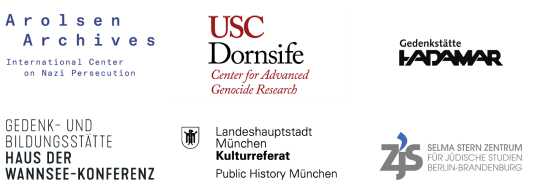Annotations
Dortmund
04/28/1942
About 300 Jews who will be deported to Zamość wait with luggage in front of the Eintracht sports hall in Dortmund. The photo was taken either upon their arrival at the assembly camp on April 28, or before their forced march to the Dortmund-Süd freight station on April 30, 1942.
Annotations
Keywords
2
Historical context
Deportation von Dortmund nach Zamość am 30.04.1942
In April 1942, the Dortmund Gestapo deported 791 Jews – 178 of them coming from Dortmund, the rest from the Arnsberg administrative district, including Hohenlimburg and Hattingen. On April 28, 1942, the persecutees from Dortmund had to gather in the gymnasium of the Eintracht sports club, which had been converted into an assembly camp, on what is now Rheinlanddamm (then Hindenburgdamm). On April 30, 1942, they had to board a 3rd class passenger train at the Dortmund-Süd freight station. Guarded by an escort team from the municipal police, the transport reached its destination after a three-day journey on May 3, 1942: the Zamość ghetto in the Lublin district. The deportees remained there for a few weeks only. It is probable that the National Socialists murdered all of them as part of their “Operation Reinhardt” agenda. None of the people deported in April 1942 are known to have survived.
About the image series
The series consists of two photos that were presumably taken in secret from a greater distance and show Jews waiting on a sports field in front of the "Eintracht" gymnasium in Dortmund. The gymnasium on today's Rheinlanddamm (then Hindenburgdamm) was used by the Gestapo as an assembly camp for 791 Jews from the Arnsberg administrative district. They were deported to Zamość on April 30, 1942, from the Dortmund-Süd freight station about two kilometers away from the gymnasium. Considering the many people to be seen in it, the second picture obviously shows the line-up of the deportees before their march to the train station on April 30, 1942.
Photographer
Unknown, Unknown
It is unclear who took the photos. Judging by the subjects of the pictures and the spatial distance to the scene, it can be assumed that the photos were taken secretly.
Provenance
It is not known who took the two photos and whether more pictures of the deportation from Dortmund were taken. The identity of the person that kept the photos after the end of the war is as unresolved as the question whether negatives or original prints have survived. According to information provided by Stadtarchiv Dortmund, the reproductions of the two photos were anonymously handed in there in the 1980s. The reproductions are now preserved in Stadtarchiv Dortmund.
Call number at source archive
Ohne Signatur
Title at source archive
Ohne Titel
Acknowledgements
The description of the photos is largely based on earlier research by Stadtarchiv Dortmund and in particular by historian Rolf Fischer, who has conducted extensive research into the deportations starting out from Dortmund (cf. Rolf Fischer: Verfolgung und Vernichtung. Die Dortmunder Opfer der Shoah. Gedenkbuch, Essen 2015, pp. 110-137).
Text and research by Henning Borggräfe und Kim Dresel.
Kooperationsverbund #LastSeen. Bilder der NS-Deportationen Dr. Alina Bothe Projektleiterin
c/o Selma Stern Zentrum für Jüdische Studien Berlin-Brandenburg
Freie Universität Berlin
Habelschwerdter Allee 34A
14195 Berlin
lastseen@zedat.fu-berlin.de
Ein Kooperationsprojekt von

Gefördert durch

Datenschutz | Impressum